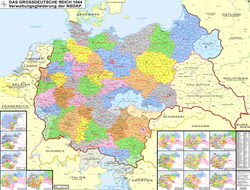Overview
In the summer of 1940, the sports department of the German government in occupied Poland organised the first football championship for German clubs in the General Government (GG). These were all clubs that had been newly founded. They included military teams from the Wehrmacht units, squadrons of the Luftwaffe, the Waffen SS and the Ordnungspolizei; occupying authorities such as the Reichspost (mail service) and the Ostbahn (Eastern Railway) also took part, as did large companies under German control, particularly in the armaments sector. In 1940, a total of 80 German football clubs were registered in the General Government. [1]
Only Reichsdeutsche and Volksdeutsche were eligible to play. Poles were not allowed to participate in organised sport, all Polish clubs and societies were dissolved and banned. Several teams signed former Polish national players who came from the Eastern part of Upper Silesia; they had been born as citizens of Prussia, but became Polish citizens when their home region was annexed to Poland in 1922. They were categorised as volksdeutsch (ethnic German) by the occupying authorities. [2]
In the major cities, the German teams played in the stadiums of the officially disbanded Polish top clubs, including the Wisla Stadium in Kraków. Construction work on the much larger Kraków Municipal Stadium, which was almost completed on the eve of the war, was finished in 1940, and under the name "Deutsche Kampfbahn" (German battle ground) it became the venue for most of the final matches for the championship and the Bernsteinpokal (Amber Cup), the cup of the General Government. [3] The officer responsible for the "Wehrmacht Stadium" in Warsaw, where Legia Warsaw had previously played its home matches, was captain Wilm Hosenfeld [4] whom Roman Polański would later commemorate in his film The Pianist (2002).
For the first two seasons, a champion was determined in the four districts of Kraków, Lublin, Radom and Warsaw. The winners of these four districts determined the champion of the Gauliga in the cup system. In 1942, the newly created District of Galicia was added. From 1942 onwards, the final round was played between the five district champions in a league system (each against each). The winner of the finals went on to the German championship.
Following a decision by the National Socialist League of the Reich for Physical Exercise, the Gauliga Generalgouvernement adapted its seasons, which previously ran from January to December each year, to structures within the Reich. This meant that the 1942 season was followed by the 1943/44 season; as a result, the championship title was not awarded in 1943. [5] In view of Germany's unfavourable situation on the Eastern Front, Gauliga matches were discontinued after the 1943/44 season.
This page is based on this
Wikipedia article Text is available under the
CC BY-SA 4.0 license; additional terms may apply.
Images, videos and audio are available under their respective licenses.
